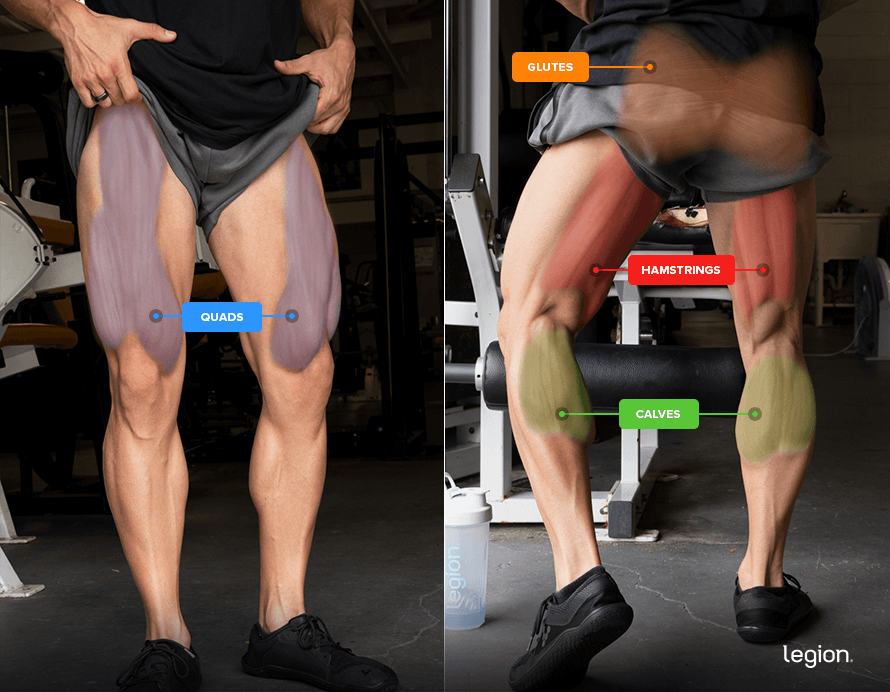[ad_1]
The dumbbell squat is an excellent yet underrated squat variation.
It trains your entire lower body, is easy to learn, and helps you build functional strength that you can use to make everyday activities easier.
In this article, you’ll learn what the dumbbell squat is, why it’s beneficial, how to perform it with proper form, how to avoid the most common mistakes, which muscles squats with dumbbells work, the best dumbbell squat variations, and more.
What Is a Dumbbell Squat?
The dumbbell squat is a lower-body exercise that involves squatting while holding a pair of dumbbells.
There are two ways to hold the dumbbells in the dumbbell squat:
- With the dumbbells resting on the front of your shoulders.
- With the dumbbells hanging at your sides.
The first option closely mimics the barbell front squat, whereas the second is more like a back squat with dumbbells.
Both are viable options, though the first requires more shoulder mobility and upper back strength to hold the dumbbells in the “front rack” position in front of your shoulders, which means it’s more suitable for people with weightlifting experience.
The upper body contributes only a small amount to the back squat with dumbbells, making it a more workable dumbbell squat variation for weightlifters of all experience levels. As such, the back squat with dumbbells is the variation we’ll focus on in this article.
The Benefits of Dumbbell Squats
1. They train your entire lower body.
The dumbbell squat works your entire lower body, including your quads, glutes, hamstrings, and calves.
Because you hold weights and must stabilize your body, it also trains some upper body muscles, such as your forearms, lower back, and abs.
2. They’re ideal for beginners.
Most consider the barbell back squat the king of squat exercises.
Although the barbell back squat is an excellent lower-body exercise, it’s not always the ideal starting point for new weightlifters. That’s because it requires a degree of balance, coordination, flexibility, and strength that not all beginners possess.
The back squat with dumbbells is a good workaround if you struggle with the barbell back squat because it allows you to train the same muscles with lighter weights. This makes the dumbbell squat a simple way to practice proper form while building your strength over time.
3. They’re functional
The squat with dumbbells mimics movements that we use in everyday life, such as sitting in a chair and standing back up.
Using the dumbbell squat to train and build the muscles involved in these movements helps develop whole-body balance, stability, and strength that makes day-to-day activities easier.
How to Do the Dumbbell Squat
To master dumbbell squat form, split the exercise into three parts: set up, squat, and ascend.
1. Set up
Stand with your feet a little wider than shoulder-width apart and your toes turned slightly out. Hold a dumbbell in each hand and allow your arms to hang at your sides.
2. Descend
Take a deep breath into your stomach, push your chest out, brace your abs, and sit down by pushing your hips backward and bending your knees at the same time.
As you descend, push your knees out in the same direction as your toes.
Keep sitting down as far as you comfortably can, ideally until your thighs are parallel to the floor or slightly lower.
3. Squat
Stand up and return to your starting position. This mirrors what you did during the descent.
Don’t let your chest fall forward or rock onto your tippy-toes—this wastes energy and makes standing up trickier.
A good cue to counter this is to think about “pushing off your heels.” This helps keep the weight centered over your midfoot throughout the squat.
Common Mistakes When Performing Squats with Dumbbells
1. Allowing your chest to fall forward.
The problem: When your chest drops, it shifts your center of gravity forward, placing undue stress on your lower back and throwing off your balance. This can reduce the effectiveness of the squat and increase the risk of injury.
The fix: Focus on keeping your chest up and your spine neutral throughout the range of motion. Imagine you’re wearing a shirt with a logo on the front, and you want to keep it visible to anyone in front of you throughout the range of motion.
2. Allowing your knees to cave in.
The problem: Your knees drift inward as you squat, which can lead to knee pain or injury over time.
The fix: Think about spreading the floor apart with your feet by driving your feet into the ground and away from each other (though they shouldn’t actually move).
This keeps your knees tracking in line with your toes (which is safer), increases the activation of your glutes, and enables you to lift more weight with a lower risk of pain or injury.
3. Swinging your arms.
The problem: Swinging your arms while squatting can throw off your balance and lead to inconsistent form, reducing the focus on your lower-body muscles.
The fix: Tightly grip the dumbbells while keeping your arms straight. Gripping tightly will increase your upper-body stability and boost the amount you can lift with your lower body. Additionally, be mindful of where you hold the dumbbells. Avoid holding them in front of your thighs, as this increases the odds you’ll hit them with your legs, causing them to swing.
The Muscles Worked by Dumbbell Squats
The main muscles worked by squats with dumbbells are the . . .
- Quadriceps (rectus femoris, vastus lateralis, vastus intermedius, and vastus medialis)
- Glutes (gluteus maximus, medius, and minimus)
- Hamstrings (biceps femoris, semitendinosus, and semimembranosus)
- Calves (gastrocnemius and soleus)
The dumbbell squat targets the core, forearms, and lower back to a lesser degree, too.
Here’s how the main muscles worked by the dumbbell squat look on your body:

The Best Dumbbell Squat Variations and Alternatives
1. Dumbbell Front Squat
The dumbbell front squat involves holding the dumbbells at shoulder height, either resting on your front delts or held up by your arms. This variation emphasizes the quads and requires more core and upper-body strength than the regular dumbbell squat.
2. Goblet Squat
You perform the goblet squat by holding a single dumbbell close to your chest with both hands. This dumbbell squat variation is beginner-friendly and excellent for learning proper squat form. The position of the dumbbell helps you maintain an upright torso, which reduces the stress on your lower back and emphasizes the quads, glutes, and core.
It’s also a great way to safely increase the depth of your squat, as the weight acts as a counterbalance, allowing you to sit deeper.
3. Bodyweight Squat
In the bodyweight squat, you use just your body weight as resistance. It’s the foundation of all squat variations and crucial for mastering the basic mechanics of squatting.
This variation is perfect for beginners or as a warm-up for more advanced weightlifters. It helps build mobility, stability, and strength in the lower body, and can help prepare you for more challenging barbell squats or dumbbell squat variations.
4. Bulgarian Split Squat
The Bulgarian split squat is a unilateral dumbbell squat variation where one leg is elevated behind you, typically on a bench, while you perform a squat with the other leg. It targets each leg individually, allowing you to find and fix muscle imbalances and enhance balance and coordination. It’s also excellent for athletes looking to improve their performance.
5. Dumbbell Sumo Squat
In the dumbbell sumo squat, you adopt a wider stance with your toes pointed outward. This variation targets the inner thighs and glutes more effectively than regular dumbbell squats.
[ad_2]
Source link

